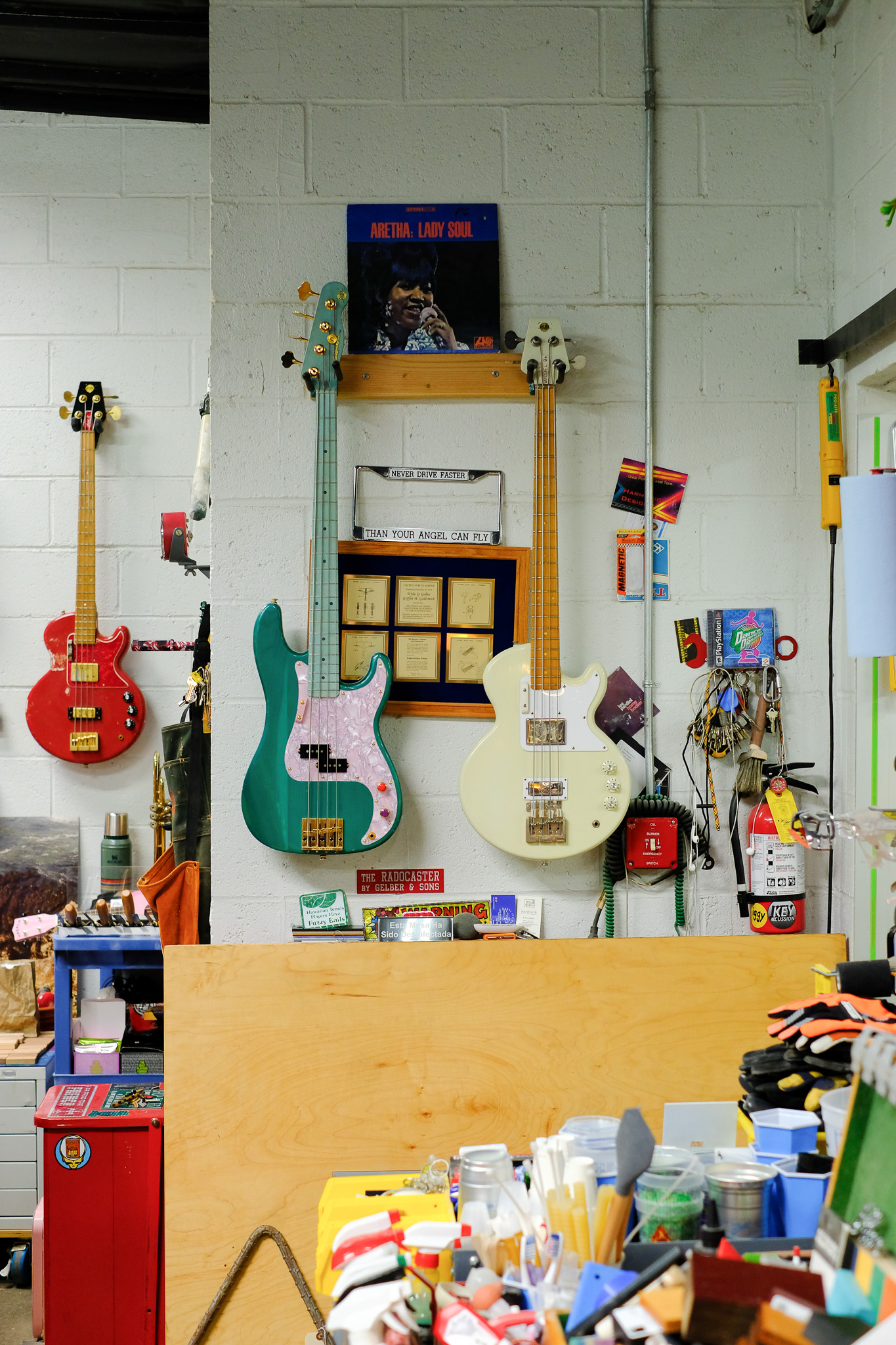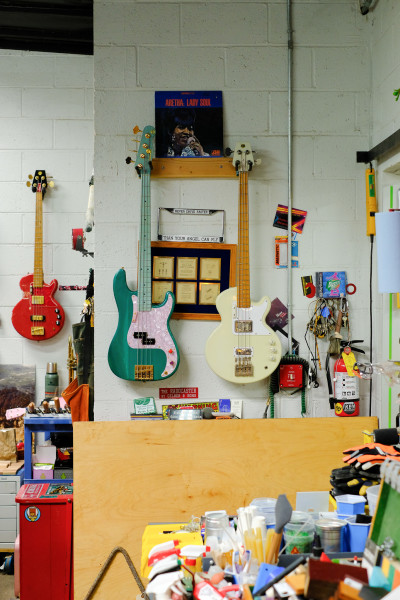In the Studio: Wylie Gelber
Talking shop in Frogtown with an LA maker.
02.24.2024

Wylie Gelber is part inventor, part craftsman and part mad scientist. We love working with him because although his thing is making custom guitars, no project or idea is ever off the table and his process of discovery and development is wondrous and so much fun. Going to his shop is like visiting the Wonka factory or something…you always leave having learned something and with a big smile on your face. We are working on all kinds of things with Wylie, including a version of Enzo Mari’s Autoprogettazione dining chair in multicolored Valchromat that’s now available at Commune Shop. Yep, whether it’s a crazy rainbow-colored acrylic chessboard or a resin doorknob with a dandelion seed head in it, when you take a trip with Wylie you never know where you are going to end up.
So Wylie, how did it all start, and how did you end up making guitars?
I spent the last 20 years on tour playing bass with my band DAWES. Throughout that time I always played the role of the in-house technician. In the beginning that meant maintaining, modifying, and retrofitting all the existing equipment and eventually it led to me wanting to build custom guitars and basses for the entire group. I loved the idea that everything on the stage had either been built or at the least meddled with by me and fortunately the rest of my band was on board. Eventually, after building an excessive amount of personal instruments, I decided to start selling them. I really love the mixture of materials that go into a guitar: metal, lacquer, wood, acrylic and as a lifelong material hunter/hoarder/researcher, there’s an unlimited amount of color and pattern combo options on a guitar which has always been my favorite part. Every guitar I make is stylistically original when it comes to the visual aspect of them, no repeats.
Were you always creative? Were you always making things?
Early on I was way into music, drawing or extensive free form Lego building. But around 17 or 18 I feel like I really found my medium of choice, which was just vaguely “tools” and building.
Where is the studio located?
By the LA river, in Frogtown. I’ve had shops in my life always, it started out as 2 milk crates with plywood in my bedroom, then I took over a second bedroom of a back house, eventually I had it up to a 2-car garage, but this is my first off site commercial location.
What are some of the more interesting tools you use for your creations?
I’m always obsessed with the versatility of my lathe, doorknobs, baseball bats, baby rattles, chess pieces, it’s like a high speed sculpting machine. The mess it makes is one of the most legendary in the shop, depending on the material, I usually scoop the shavings off the floor, recast them in resin and put em back on the lathe an unlimited amount of times.
Additionally, within the walls of my studio I could not live without my vintage rotary engravers. I’m sure not everyone has been completely enamored by municipal engraved plaques their entire life. But I have. And I have the machines that make them. Organizing and constantly honing the systems of my shop has always been one of my favorite activities.
Tell us about where you find inspiration and your obsession with plastic.
I think I’ve just always been obsessed with man-made materials. Acrylics, resins, plastics, Bakelite, acetate, etc., I love how uniform they are, I love how they cut and sand and polish. So, I’ve been sourcing and collecting every color, pattern, and thickness of them for years and the more I work with them, the easier I find it is to incorporate them into all types of builds that those type of materials rarely show up in.
I’m a big visual researcher and I love industrial design, especially of the 80s and 90s. So, whether I’m researching light switches, metal ladders, handles, signage, I’m always screen-shotting or taking photos of the unintentional color pallets that you often see in the “commercial wild.”
I love to walk every aisle of an amazing hardware store, looking at bolts, tapes, glue bottles, tool displays. I spent 20 years traveling and made it into as many hardware stores as I could, in every city and country I went to.
I love the hunt for the most beautiful of a mundane item, power strips, door locks, electrical outlets. I love details, screw head choices, hinges, knobs. Having an understanding of all the different types of everything, in regard to an item or detail most people don’t even care about, can be extremely inspiring to me when I’m building.
Are there any other objects you’re curious about exploring?
I’m starting to explore metal machining, as in, my toe has not even fully been dipped. But I love the idea of turning metal knobs or just cutting myself custom bolts out of a rod of steel.
Tell us about the tool that you use “to catch” dandelions.
When I’m doing my cast dandelion knobs, getting them set into resin was obviously tricky and came with a steep learning curve, but before that process even begins I literally walk the streets by the studio hunting the perfect specimens and then depending on how far I’ve wandered, getting them back to the studio was completely hit or miss. I’d be holding one dandelion in each hand, after snipping them off someone’s front yard, then I’d walk so incredibly slow back to my studio holding them out in front of me, only to accidentally blow them away feet from my front door. I used some mason jars, roach clips, super glue, plywood, and a playground handle I had laying around and made a transportation vessel for them where they are suspended upside down in individual jars, and I look slightly less unhinged while I’m “working”.
Tell us about the projects that you’re working on for Commune.
I love working on things with people with specific and discerning taste. Making 1 of 1 items, designed for exact spaces or rooms in mind, giving me guidelines I trust and then letting me do my thing is my ideal collaboration method. Everything I’ve been doing with Commune has been exactly that.
Photos by Dante Iniguez




































